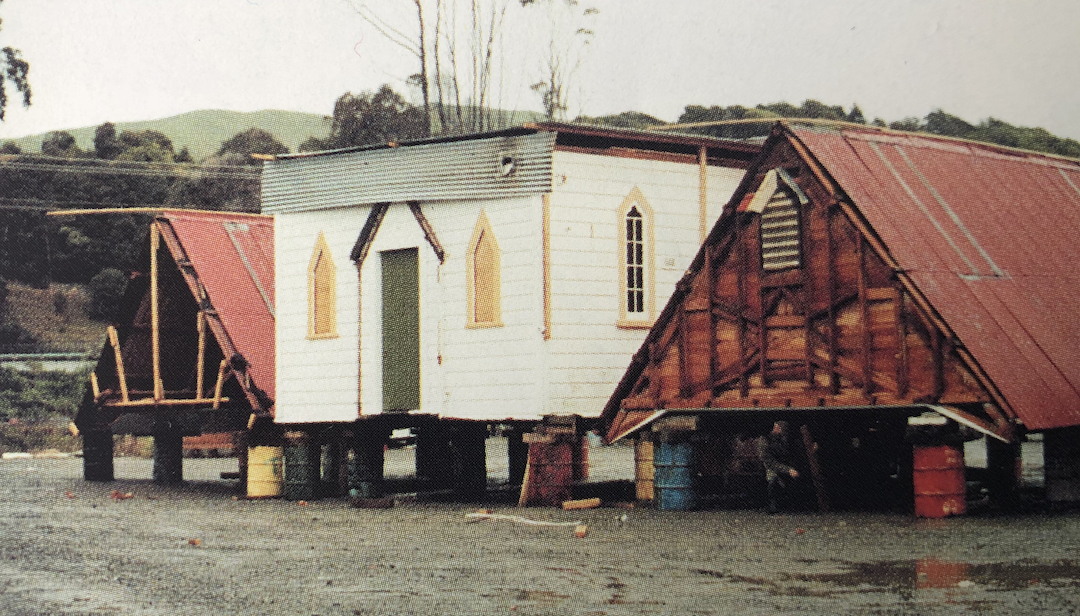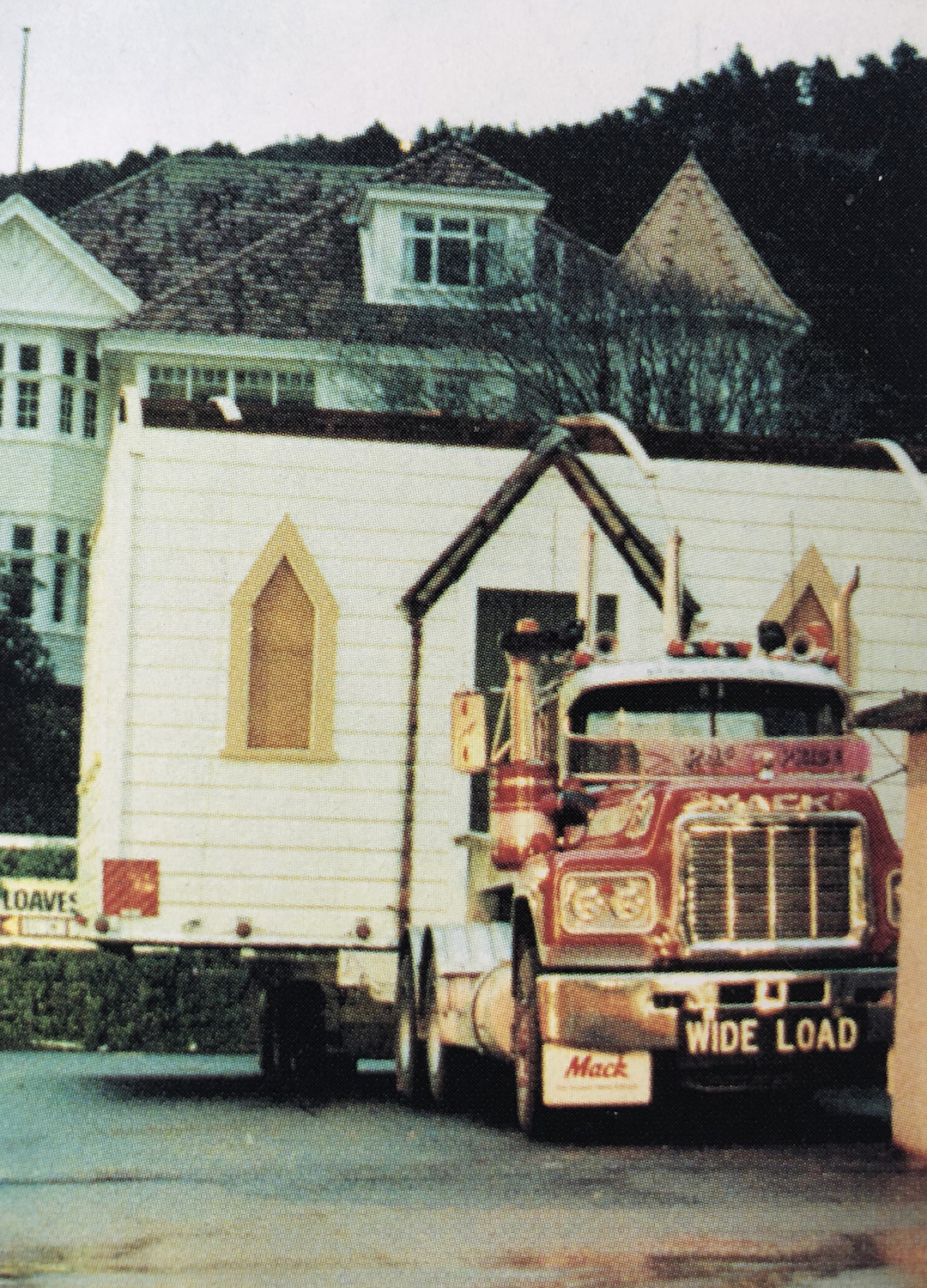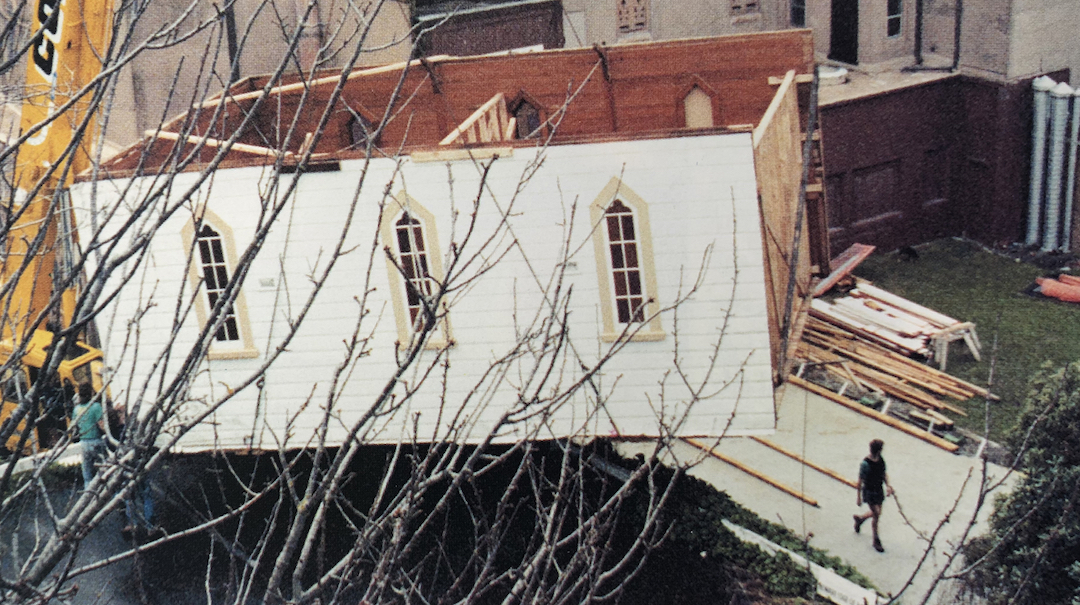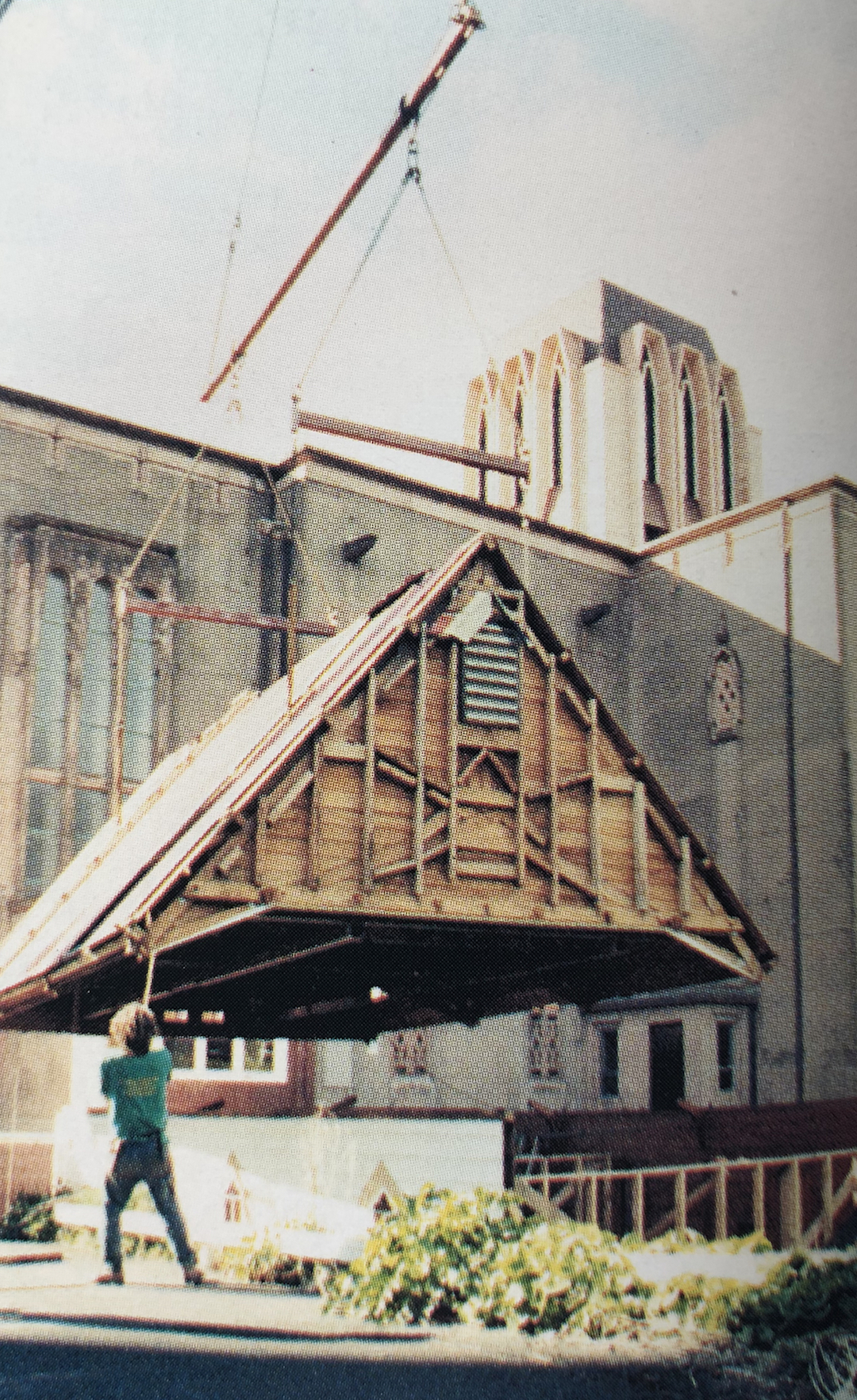Lady Chapel
Early history
The Lady Chapel was formerly the parish church of St Paul's at Paraparaumu. Designed by the diocesan architect Frederick de Jersey Clere, 1856-1962, the church was opened on its Paraparaumu site in 1905.
Frederick de Jersey Clere, c. 1936
Frederick de Jersey Clere was born at Walsden, in the north of England. Son of a clergyman, he trained in Brighton and London and came to New Zealand during 1877. He set up in private practice in Wellington and in 1883 he was appointed Wellington's diocesan architect. He retired from private practice at 90 and died aged 96.
His was a long career during which he designed some 120 churches, 80 of which were in the Wellington Diocese. As well as working extensively for the Anglican Church, he undertook commissions from other denominations.
In the Wellington area, Clere churches include St Mary of the Angels, Boulcott Street; St Andrew's on the Terrace; St Mary's Church, Karori; All Saints' Church, Hataitai; St Barnabas', Khandallah; St Luke's, Wadestown and St Augustine's, Petone.
However Clere designed several other landmark city buildings including Wellington Harbour Board offices and bond store at Queen's Wharf (now Wellington Maritime Museum), St Gerard's Monastery and the chapel at the Star of the Sea Convent, Seatoun.
The opening of St Paul's Church, Paraparaumu, in 1905, followed three years of dedicated fundraising by the church's building fund ladies' committee. The Paraparaumu settlement was then part of the Parish of Otaki; it became an independent parish in 1908.
In 1902, 74 pounds had been set aside for the building of a future church in Paraparaumu. In 1903, the building fund committee swung into action and more than doubled the amount. By September 24, 1904, when a public meeting was called and a building committee set up, the enterprising women had raised 153 pounds, 13 shillings and threepence. With promises of other donations they had a building fund of 206 pounds, 13 shillings and threepence. It was sufficient for the project to begin.
The meeting, held in Paraparaumu Schoolroom "in connection with the proposed buildings of an Anglican Church", elected Messrs Hadfield, Litton, Gerrard, Harveson and Howell to serve on the building committee. The women of the parish had overseen the fund raising, now it was the men's turn to see that the church was built.
Some of the land for the church on the site in Cinema Street, to the east of the railway line, was bought by public subscription and some was given by a building committee member, Henry Hadfield, whose memorial plaque is in the chapel.
The committee engaged Frederick de Jersey Clere as architect and supervisor for a fee of five pounds, 13 shillings and fourpence. Daniel Nees of Manakau submitted the lowest tender for the building, 249 pounds "complete with belfry, spouting etc".
Before it was moved, the Lady Chapel used to be the parish church in Paraparaumu
Though there were several other similar small churches in the parish, in 1910 the vicarage was built alongside St Paul's and this, and the fact that the church was then centrally placed in the district, ensured that it became the mother church of the parish.
In 1990, there was need for a larger church in Paraparaumu nearer the main residential areas. After this was built, Paraparaumu Parish generously donated the historic church to the Cathedral to serve as its Lady Chapel. On May 12, 1991, it was consecrated as the Lady Chapel by the Most Reverend Brian Davis, Archbishop of New Zealand and Bishop of Wellington.
On the move
A Lady Chapel dedicated to the Virgin Mary has long been part of Cathedrals and major churches. In England, the more famous of them include the Chapel of Our Lady, in the Norman crypt at Canterbury Cathedral; the 12th century Lady Chapel at Durham Cathedral and Winchester's 13th century Lady Chapel.
The Lady Chapel at the Wellington Cathedral of St Paul is located along the ambulatory to the left of the pulpit. A plan for a Lady Chapel in this position was part of the original vision of architect Cecil Wood in his design for a cathedral, a plan which was adopted in the late 1930s.
Here, as in many cathedrals worldwide, the Lady Chapel offers a quiet place for reflection and prayer. The chapel is used for midday Communion and is also used for baptisms, weddings and funerals. Originally it had been planned to move the sanctuary and chancel of Old St Paul's from Mulgrave Street to the cathedral to serve as the Lady Chapel. The foundations and walls to support this move were begun when the Cathedral's sanctuary and chancel were being built.
This move of part of Old St Paul's was not to be; the church was sold to the New Zealand Government, and restored.
By 1990 the area reserved for the Lady Chapel looked similar to a monastic ruin on the side of the Cathedral, with concrete walls about a metre high forming the outline of the base.
Despite the modern design of the Cathedral, it was still, however, thought appropriate to have an old wooden church as a Lady Chapel as a reminder that the first parish church in Thorndon was just such a simple wooden structure. The first St Paul's Church stood in Museum Street to the rear of what is now the Beehive extension of the Houses of Parliament, and was later demolished.
A replica of the church was recently built as an information centre for Bolton Street Memorial Park and is located at the Bolton Street entry to the park.
In New Zealand, where churches, like houses, are often made of wood there is nothing unusual about moving a building to a new site from many kilometres away. After foundations had been laid at the Cathedral, the old church was removed from Kapiti in two stages.
First, it was trucked north by the contractors to a yard on the bank of the river at Waikanae so additions made to the building in the 1960s could be removed. Then on the night of September 10, 1990, the main section of the building was loaded on to a truck for the journey south to Wellington. The roof followed on the next night.
Once on site, the building was extended. One bay and an apse were added to enlarge the sanctuary and a short connection of similar construction was built to join the new chapel to the Cathedral. The building was refurbished in late Victorian-Edwardian style to match the period in which it had originally been built.



Photographs by Jay Berryman
The Chapel Windows
The golden-coloured Rimu timber of the Lady Chapel has been offset by a predominance of rich blues. Blue is the colour associated with the Blessed Virgin Mary, Our Lady, and was the logical choice for a chapel dedicated to her and for the ten stained-glass windows focussing on her life.
““I design with prayer and an openness to the guidance of the Holy Spirit. I do not approach the task as if creating a work of art as such””
"Stained glass has been and still is a powerful means of communication," says Beverley Shore Bennett who designed the windows. "It has the ability to express the inexpressible in that it uses direct light as its main medium. This has always been the power of stained glass since the Middle Ages. Stained glass, in the days when people didn't read, was the poor person's Bible. The windows still give insight to the way things looked and the spiritual aspect of life. I design with prayer and an openness to the guidance of the Holy Spirit. I do not approach the task as if creating a work of art as such".
A noted stained-glass designer, her other works in the Cathedral include the Holm window, over the three doors lead to the Loaves and Fishes Hall, and windows in the ambulatory. She designed the Cathedral's main baptismal font, and designed and made the magnificent dossal hanging behind the main Cathedral altar. Beverley Shore Bennett was Lay Canon for the Arts on the Cathedral Chapter and is now a Lay Canon Emeritus.
The windows do not cover Mary's life in chronological sequence. That was so the two outstanding events of her life - the birth and death of her son Jesus - would be in focus close to the altar.
The remaining windows represent the Annunciation, Visitation, Magnificat, Presentation in the Temple, the Epiphany, the Flight into Egypt, Jesus in the Temple and the Miracle of Wine at Cana.
Stephen Belanger-Taylor, an English-trained stained glass artist, interpreted the designs while living in Canada. Antique glass of the finest quality has been used, while special pieces have been made by Stephen's wife Denise, a hot glass artists. The glass is called antique as it is made in the traditional age-old method, the bubbles, streaks and irregularities attracting light and adding liveliness to the effect of the windows. The figures are in grisaille, a monotone technique, set off by the rich blue of the backgrounds, further enhanced by the borders of ruby, pink and gold glass.
Click on the photos below to see the whole window with caption.
Inside the Chapel - points of special interest
The Lady Chapel is built in native timbers. It is predominantly rimu with matai used for flooring.
The altar is made from rimu and came from St Augustine's Church, Cashmere, Christchurch. It had been replaced in the early 1970s when that church was refurbished and redeveloped. The cross on the altar belonged to the chapel when it was the parish church of St Paul's at Paraparaumu and came with the building from Paraparaumu.
The altar rail and lectern came from the Parish of All Saints, Burwood, in the diocese of Christchurch. The church was consecrated in 1877 and was in use until 1973 when a new church was built; the lectern had been given as a 50th jubilee gift in 1927.
The altar frontals, seen through the panels of wood at the front of the altar, were designed and made by the Cathedral Linen Guild. The purple and red frontals were adapted from altar hangings used in the church when it was in Paraparaumu. The green and white frontals were newly made by the guild. Designs on the altar frontals match the vestments and go with the different seasons of the Church year. The guild also made the two linen altar cloths specially for the chapel.
Toc H lamp: Toc H is a Christian service and fellowship organisation. Formed in Britain in 1915, Toc H came to New Zealand in 1925. The Toc H symbol is a lamp, a replica of those used in the catacombs in Rome when Christianity was young and an underground movement.
The memorial plaques were placed in the chapel in its early years when it was the parish church of St Paul's, Paraparaumu, and are in memory of members of the family of Octavius Hadfield, second Bishop of Wellington and, from 1890 to 1893, third Anglican Primate of New Zealand. The Hadfield family was prominent in the building, and later the running, of the original St Paul's Church.
The prayer desk on the south side of the altar is made from 13th century timber from the roof of St George's Chapel, Windsor, England, and frames a medieval carver's sample. This came from Coventry, England, and would have been one of the samples used by monks of the Abbey Church of St Michael from which to select carvings for the building.
Built in the 14th and 15th centuries, the abbey became the first Coventry Cathedral. It was destroyed by bombing in 1942 during World War II and the carving remains a rare example of the decoration used in that cathedral, which is now a ruin, lying adjacent to the post-war Coventry Cathedral. The desk was a gift to the Wellington Cathedral by journalist, author and editor, Hector Bolitho. Born in Auckland in 1898, he was editor of the Sydney Sunday News but was best known for his biographies on royalty. He died in 1974.
The president's chair is made of thirteen pieces of timber linked with early New Zealand - it took 18 months to collect the samples. The chair is on permanent loan from the New Zealand Founders Society.
Kauri - taken from a block beneath the stone doorstep of Kemp House, the first European house built at Kerikeri, Bay of Islands, in 1815.
Part of the second bridge put across the Balclutha River, Otago, in 1880.
A piece of Australian hardwood from a log retrieved from the cargo of the brig Boyd which was attacked by a group of Māori in 1809 in Whangaroa Harbour. This attack was in retaliation for the captain’s mistreatment of a young local chief, Te Ara, who had sailed from Sydney on the Boyd. For more information please see this page.
Part of a gatepost from The Elms, the Church of England Mission property established at Tauranga in 1835.
Matai, from a chest of drawers made in the Wairarapa in the 1870s. The wood in the chest was hand-hewn from the log and hand-dressed.
Kauri, from one of Nelson's oldest existing buildings, originally a school run by the Nelson Schools' Society, founded by Matthew Campbell, 1815-1883. The foundation stone of what became known as the Campbell School was laid in 1844. The school building was in use for 50 years when, with its land, it was conveyed to the trustees of the Bishop Suter Art Gallery. Part of the school still exists as the front wall between the new and the old exhibition halls.
Totara, from one of the three main carved pillars which supported the solid ridge of the Rotorua Meeting House of the Confederation of Te Arawa Tribes. The tree had been felled in 1866.
Red beech weatherboard from a building erected in Lawrence, Otago, in 1867, and dismantled in the early 1940s.
Honduras mahogany, from a pay chest off HMS Orpheus, wrecked on the Manakau Bar in 1863. A brass plate on the chest bore the date 1720.
English oak, from a tree planted at Tamahere, Hamilton, in 1864.
Matai, from St John's Anglican Church, Te Awamutu, built from money raised in 1853.
Part of a pointed picket post from the stockade of the Tutakomoana Pa Fort, in use in the Taupo district up to 1830.
The Litany prayer desk on the north side of the altar was the gift of the Parish of Kelburn. A litany desk was by custom placed at the front of the nave and was the place from which the Litany, a formal set of prayers, was read. Such desks were never heavily carved so the congregation could have a clear view of the altar.
The chapel organ was made in London in 1961 by the well known organ builders J W Walker and Sons and was shipped to New Zealand for the Calvary Hospital Chapel. When the hospital was sold by the Order of the Little Company of Mary, the organ was moved from the chapel and the building demolished.
Local organist Janet Gibbs bought the instrument and for 18 months it was stored in the basement of St Andrew's on the Terrace,. It was then loaned to St Andrew's Church, Newlands. Finally it came to the Lady Chapel in 1991, again on loan. In 1993 it was purchased for the Cathedral.
The banners belong to two major Anglican women's associations. The banner for the Association of Anglican Women shows a map of the southern half of the North Island and the outline of the Wellington Diocese as it was at the time the banner was made in 1994. Ann Parnell, a member of the association, made the banner from a wool fabric. The outline of the land is in shot silk, with the diocesan boundary outlined in pink. The Mothers' Union banner is the older of the two and was brought to the Cathedral from Old St Paul's where it originally hung.
On either side of the chapel doors, in the ambulatory, are two brass plaques. The one on the right details a brief history of the chapel, the one to the left commemorates the generous bequest of Berenice Vivienne Ashton Luke, who in loving memory of her parents, William Webb Luke 1877-1945 and Mary Ann Luke 1877-1962, made possible the provision of the chapel.
Text drawn from a guide book to the Lady Chapel written by Judy Bradwell, available for purchase from the Cathedral office.













